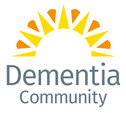Spoiled for choice? Two different models for using music in a care home organisation
Latham I. Spoiled for choice? Two different models for using music in a care home organisation. Journal of Dementia Care 32(6)18-20.
Isabelle Latham describes two different models of using music in Hallmark Care Homes, and the benefits and challenges of each. She urges better coordination between arts practitioners and services to improve outcomes for all
Author Details
Isabelle Latham is Researcher in Residence, Hallmark Care Homes
It is now widely accepted that music and music-based interventions are not only enjoyable for people living with dementia, but also impactful in a variety of ways (Abrah 2016; Livingstone et al 2014; Platel 2022). Many care homes therefore aim to integrate music into their everyday support for residents living with dementia, (Meadows & McLennan 2022) moving beyond only utilising music in large group activities or via external entertainers and performers towards more therapeutic applications, (Platel 2022; Playlist for Life 2024). As a result of this, there is now a proliferation of approaches to using music and organisations that provide guidance, training or expertise to care homes. This is undoubtedly a positive development, but it can mean challenging decision-making for care home providers when choosing the type of approach and means of implementation within individual care homes.
Over the last four years, Hallmark Care Homes has applied two different models of using music in their care homes, and recently had the opportunity to reflect on their various benefits and challenges. This article describes those two models, their contribution to the resident experience and the challenges of implementation. It also makes a case for more coordination in this area to enable care providers to access different models as required for individual residents.
A spectrum of opportunities
When considering the range of music available, Hallmark found it useful to think of opportunities as existing on a spectrum, from those that support care staff (usually via training) to integrate music into daily care, thus impacting multiple residents, to those that provide specialist music therapy to specific individuals with identified need.
Figure 1 illustrates this spectrum.
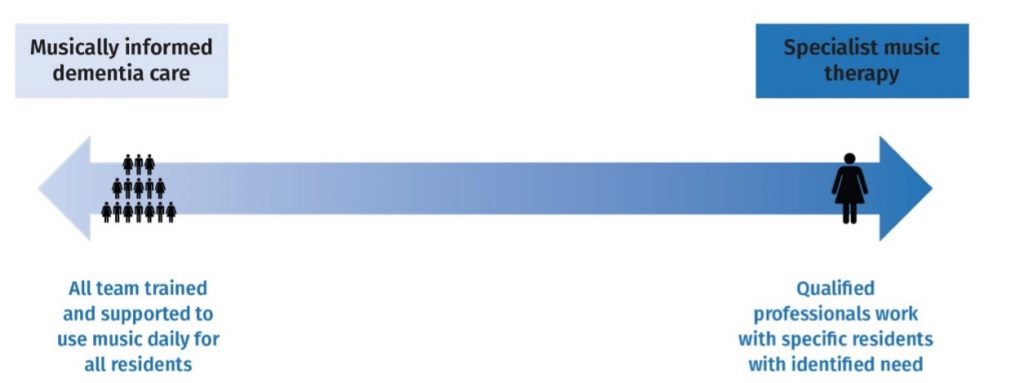
“Music on Prescription” Service
Partnered with Musica CIC to link experienced musicians (not music therapists) with residents who would benefit
Care home referred individual residents with interest/background in music who needed extra support to reduce distress and/or Isolation
Musicians work one-on-one with resident in the care home using bespoke musical activities.
Musica musician visited resident 1 hour per week across 12 weeks and fed back to the care team
Necessary equipment sourced by care home or musician
Online training available to all team members.
Creating Individual Playlists
Partnered with Playlist for Life. Regional team members certified to deliver “Playlist for Life” training
Playlists training delivered to key staff in the care home
Coaching support for staff provided weekly for 12 weeks by regional dementia team
Care homes provided with necessary equipment (dementia-friendly radios, headphones, MP3 players etc.)
Playlists initially developed and used for at least 6 residents per care home and expanded further if possible
Online training available to all team members
Care home worked toward Playlists for Life accreditation.
Figure 2—models of using music at Hallmark.
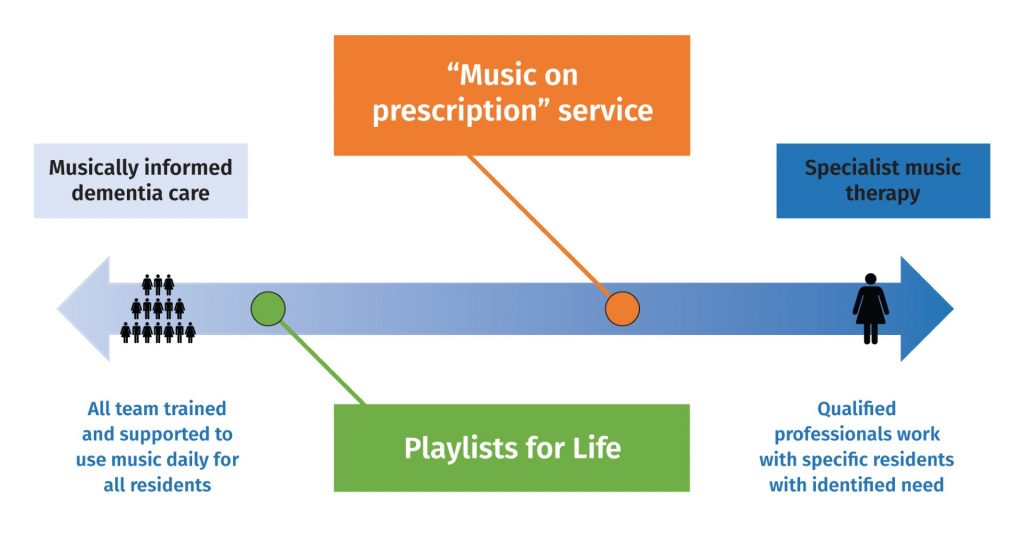
Utilising music at Hallmark
As part of an evolving dementia strategy, different ways of integrating music across the organisation’s homes are considered as they are discovered. In recent years, two models have been experienced by a selection of our care homes. The models are described in Figure 2 and the two models contrasted in Figure 3 (both above).
Hallmark chose to explore both these models to consider the impacts and practical requirements of each. Playlist for Life is a well-recognised model and had the potential to benefit large numbers of residents in each care home over the long term. However, a more specialist approach using the skills of experienced musicians had the potential to benefit particular individuals to a greater degree. While music therapy with qualified therapists would be considered a gold standard individual intervention, it can be hard to source and employing therapists directly is not feasible for an organisation of Hallmark’s size and geographical reach. Therefore, partnering with Musica CIC* enabled exploration of a ‘middle ground’ between generalised playlist approaches and individualised music therapy.
*Musica Music and wellbeing CIC can be contacted via LinkedIn:
https://www.linkedin.com/company/musica-music/
Impacts
Both models led to overwhelmingly positive impacts for those involved. Playlists enabled the development and use of playlists for 13 residents over three months, with resident-users experiencing benefits in terms of reduced distress, increased communication, improved emotional well-being and increased engagement. Staff members also benefitted, reporting improved ability to connect with residents, better awareness of resident ability and improved response to resident distress. Looking forward, Playlist for Life was confirmed to be useful for a significant proportion of residents in Hallmark care homes, but required additional support (one-to-one coaching and action planning) alongside training to navigate required technology and ensure effective, ongoing implementation. Without this support, implementation would probably have failed.
Musica on Prescription* successfully operated a referral system for four residents over three months, each of whom received bespoke, creative interventions with musicians including composing music, playing instruments and musical reminiscence. Individual residents built relationships with the musicians and experienced improved mood, reduced distress, increased communication and better engagement with the care home community overall. Staff reported a better understanding of residents and integrating musician-inspired approaches into daily care. Support was required to help the musician understand the care home and connect with staff, but once this occurred little external support was needed. In the future, Musica on Prescription would be a valuable resource to “socially prescribe” for specific residents in each of our care homes.
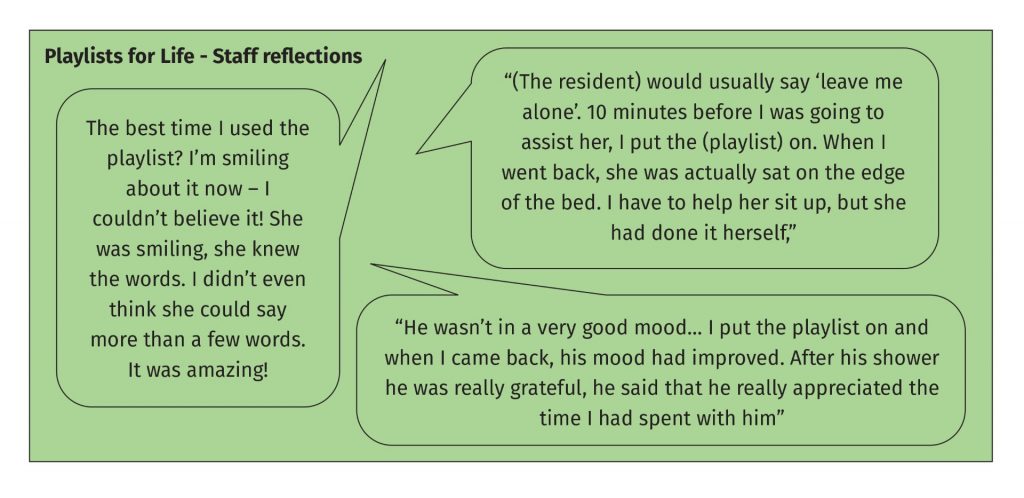
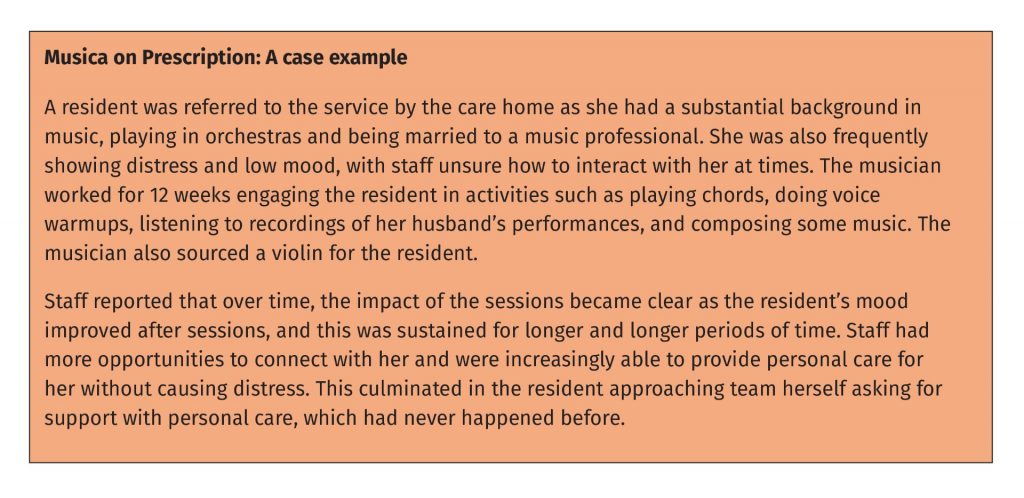
What does the future hold?
Since early 2024, Hallmark Care Homes has focused resources on implementing Playlist for Life across all 22 care homes, with several already receiving accreditation. This is supported by an organisational implementation initiative – known as an “Outstanding Pathway” – which provides bespoke guidance and support for each care home to apply the learning into practice and effectively sustain the use of music and playlists in the home. This direction was taken to ensure the widest impact on residents and to increase the consistency and sustainability of our provision over the next few years.
The experience with Musica on Prescription has shown that the ability to “socially prescribe” for specific residents can be valuable and impactful, and the model used could be applied to other practitioners and qualified therapists (e.g. drama, dance, art). However, because of its specialist nature, this is challenging to implement more widely. Unless an organisation can logistically and financially justify the in-house employment of such practitioners, provision is limited by geographical availability and capacity of (usually small or single-person) providers of such services. This means longer term use of this type of resource by those in care homes (and thus the incentive for practitioners to develop and offer such services) will remain limited until larger scale solutions can be found.
A future in which the diverse, bespoke and geographically dispersed needs of residents for this type of resource could be easily connected to the diverse, bespoke and geographically dispersed providers of such services across the UK is something that would benefit a wide range of care providers and those skilled to deliver such services. Hallmark Care Homes will be exploring this further, so watch this space!
References
Abraha I, Rimland JM, Trotta FM et al (2016) Systematic review of systematic reviews of non-pharmacological interventions to treat behavioural disturbances in older patients with dementia. The SENATOR-OnTop series BMJ Open 2017;7:e012759. doi: 10.1136/bmjopen-2016-012759
Livingston G, Kelly L, Lewis-Holmes E, Baio G, Morris S, Patel N et al (2014) A systematic review of the effectiveness and cost-effectiveness of sensory, psychological and behavioural interventions for managing agitation in older adults with dementia. Health Technology Assess;18(39).
Meadows G, McLennan H (2022) The Power of Music (Music for Dementia). https://utleyfoundation.org.uk/wp-content/uploads/2024/06/Power-of-Music-Report.pdf
Platel H (2022) ‘Music Therapy’ in: Psychosocial Interventions in Dementia; understanding, knowing, implementing (Fondation Mederic Alzheimer)
Playlist for Life (2024) The Benefits of Personalised Playlist accessed at: https://www.playlistforlife.org.uk/about-us/
